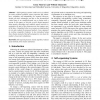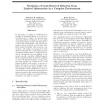318 search results - page 51 / 64 » Evolving RBF Neural Networks |
IJCNN
2008
IEEE
14 years 2 months ago
2008
IEEE
— The first-person-shooter Quake II is used as a platform to test neuro-visual control and retina input layouts. Agents are trained to shoot a moving enemy as quickly as possibl...
ICMCS
2010
IEEE
13 years 9 months ago
2010
IEEE
Heterogenesis is an interactive sound and tactile installation consisting of a group of autonomous artificial agents that collectively generate and evolve a soundscape in response...
GEM
2009
13 years 5 months ago
2009
Self-organizing systems could serve as a solution for many technical problems where properties like robustness, scalability, and adaptability are required. However, despite all the...
JMLR
2010
13 years 2 months ago
2010
Learning dynamic Bayesian network structures provides a principled mechanism for identifying conditional dependencies in time-series data. An important assumption of traditional D...
GECCO
1999
Springer
14 years 5 days ago
1999
Springer
In this paper, we apply an evolutionary algorithm to learning behavior on a novel, interesting task to explore the general issue of learning e ective behaviors in a complex enviro...


